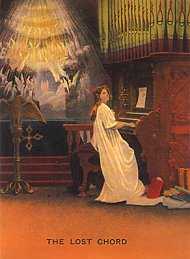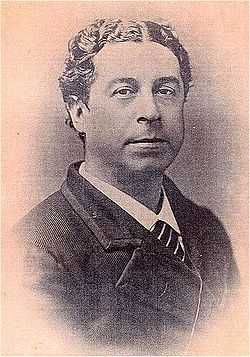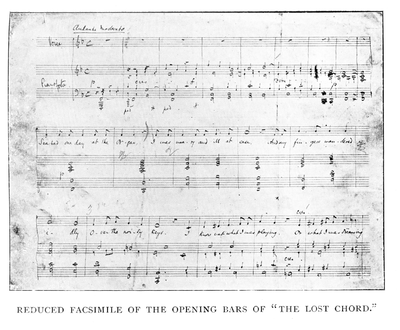The Lost Chord

"The Lost Chord" is a song composed by Arthur Sullivan in 1877 at the bedside of his brother Fred during Fred's last illness. The manuscript is dated 13 January 1877; Fred Sullivan died five days later. The lyric was written as a poem by Adelaide Anne Procter called "A Lost Chord," published in 1858 in The English Woman's Journal.
The song was immediately successful[1] and became particularly associated with American contralto Antoinette Sterling, with Sullivan's close friend and mistress, Fanny Ronalds, and with British contralto Clara Butt. Sullivan was proud of the song and later noted: "I have composed much music since then, but have never written a second Lost Chord."[2]
Many singers have recorded the song, including Enrico Caruso, who sang it at the Metropolitan Opera House on 29 April 1912 at a benefit concert for families of victims of the Titanic disaster.[3] The piece has endured as one of Sullivan's best-known songs, and the setting is still performed today.[4]
Background

In 1877, Arthur Sullivan was already Britain's foremost composer, having produced such critically praised pieces as his Irish Symphony, his Overture di Ballo, many hymns and songs, such as "Onward, Christian Soldiers", and the popular short operas Cox and Box and Trial by Jury. Adelaide Anne Procter was an extremely popular poet in Britain, second in fame only to Alfred Lord Tennyson.[4] On the early published sheet music for the song, Procter's name is written in larger letters than Sullivan's.[5] Sullivan's father's death had inspired him to write his Overture In C (In Memoriam) over a dozen years earlier.
The composer's brother, Fred Sullivan was an actor who appeared mostly in operettas and comic operas. Playwright F. C. Burnand wrote of Fred: "As he was the most absurd person, so was he the very kindliest. The brothers were devoted to each other, but Arthur went up, and poor little Fred went under."[6] Fred played roles in Offenbach operettas, among others, in London and on tour. He created the roles of Apollo in Gilbert and Sullivan's Thespis (1871), and the Learned Judge in their Trial by Jury (1875). He most likely would have played the title role in Gilbert and Sullivan's The Sorcerer (1877), but he fell ill in 1876 and died before that work was produced.
During Fred's final illness, Arthur visited his brother frequently at his home on King's Road in Fulham, London. The composer had tried to set Procter's poem to music five years previously but had not been satisfied by the effort.[7] As he had been inspired by his grief at the death of their father, he was again inspired to compose by his brother's decline. At Fred's bedside, he sketched out the music to The Lost Chord.[8] Although not written for sale, the song became the biggest commercial success of any British or American song of the 1870s and 1880s. The American contralto Antoinette Sterling became one of its leading proponents,[7] as did Sullivan's close friend and sometime mistress, Fanny Ronalds,[4] who often sang it at society functions.[8] Dame Clara Butt recorded the song several times, and many famous singers recorded it, including Enrico Caruso in 1912.[5][3] A copy of the music was buried with Ronalds, who bequeathed the manuscript to Butt in 1914. Butt's husband, baritone Kennerley Rumford, gave the manuscript to the Worshipful Company of Musicians in 1950.[9]
Musicologist Derek B. Scott offers this analysis of the composition:
| ||||
Sullivan's setting is structurally sophisticated in its treatment of Procter's verses, and offers a contrast to... simple strophic setting.... This demonstrates the variety of forms to be found in drawing-room ballads before there were moves toward greater homogeneity in the 1880s.... For the most part, the song steers clear of the predictable.... There are some delightful surprises, such as the sudden coloring of the harmony with the old church Mixolydian mode as the singer recounts the striking of the mysterious chord. Sullivan shows a thorough understanding of the possibilities of the piano, ranging widely across its compass and making powerful dynamic and textural contrasts. He also does a fine job of imitating an organ style in the introduction. Sullivan's compositional skill where words are concerned is evident in the way he treats the quatrains of Procter's poem... creating a subtle musical structure that avoids an obviously sectional character, despite the poem's hymn-like form.[7]
1888 recording for Edison
| ||||
In 1888, Thomas Edison sent his "Perfected" Phonograph to Mr. George Gouraud in London, England, and on August 14, 1888, Gouraud introduced the phonograph to London in a press conference, including the playing of a piano and cornet recording of Sullivan's "The Lost Chord," one of the first recordings of music ever made.[10]
A series of parties followed, introducing the phonograph to members of society at the so-called "Little Menlo" in London. Sullivan was invited to one of these on October 5, 1888. After dinner, he recorded a speech to be sent to Thomas Edison, saying, in part:
| “ | I can only say that I am astonished and somewhat terrified at the result of this evening's experiments: astonished at the wonderful power you have developed, and terrified at the thought that so much hideous and bad music may be put on record forever. But all the same I think it is the most wonderful thing that I have ever experienced, and I congratulate you with all my heart on this wonderful discovery.[10] | ” |
These recordings were discovered in the Edison Library in New Jersey in the 1950s.[10]
Text


Seated one day at the organ,
I was weary and ill at ease,
And my fingers wandered idly
Over the noisy keys.
I know not what I was playing,
Or what I was dreaming then;
But I struck one chord of music,
Like the sound of a great Amen.
It flooded the crimson twilight,
Like the close of an angel's psalm,
And it lay on my fevered spirit
With a touch of infinite calm.
It quieted pain and sorrow,
Like love overcoming strife;
It seemed the harmonious echo
From our discordant life.
It linked all perplexèd meanings
Into one perfect[1] peace,
And trembled away into silence
As if it were loth to cease.
I have sought, but I seek it vainly,
That one lost chord divine,
Which came from the soul of the organ,
And entered into mine.
It may be that death's bright angel
Will speak in that chord again,
It may be that only in Heav'n
I shall hear that grand Amen.
- ^ Given the musical allusions in this lyric, the reference to "perfect" seems intended to have the added meaning of a perfect fourth.
Cultural influence
- In film and television
There have been at least six films titled The Lost Chord, as well as one titled The Trail of the Lost Chord.[11] In the 1999 film Topsy-Turvy, a scene depicts Fanny Ronalds (played by Eleanor David) facetiously introducing it as "a new composition" at an 1884 party at her house; she then sings it with Sullivan (Allan Corduner) at the piano and Walter Simmonds (Matthew Mills) at the harmonium.[5]

The Strangers TV series had an episode called "The Lost Chord."[12]
- Music
Jimmy Durante recorded a humorous song called "I'm the Guy Who Found the Lost Chord", which he also sings in the 1947 film This Time for Keeps.[13] George and Ira Gershwin wrote a song called "That Lost Barber Shop Chord", which was included in their 1926 revue Americana.[14] In Michael Flanders and Donald Swann's comic song, "The Reluctant Cannibal", the opening line is "Seated one day at the tom-tom", a reference to the first line of "The Lost Chord." The Moody Blues produced an album called In Search of the Lost Chord in 1968. According to keyboardist Mike Pinder, the title was inspired by the Durante song.[15]
- Literature and other
The novel Bad Wisdom by Bill Drummond and Mark Manning concerns their trip to the North Pole with an icon of Elvis to search for the Lost Chord. Edith Wharton's novel Ethan Frome contains references to the song. In Isaac Asimov's Black Widowers story "The Quiet Place" (Ellery Queen's Mystery Magazine, March 1988), the traditional "Guest" of The Black Widowers hums this tune all through a dinner. Caryl Brahms wrote a book called Gilbert and Sullivan: Lost Chords and Discords (Boston: Little, Brown and Company, 1975).
An organization called The Lost Chord describes itself as "a collaborative effort to nurture young talent from underprivileged communities and to foster a commitment to music and arts education accessibility in the New England community."[16]
Notes
- ↑ Jacobs, p. 2
- ↑ "The Lost Chord", The Gilbert and Sullivan Archive, accessed 13 August 2014
- ↑ 3.0 3.1 1912 Caruso recording, Encyclopedia-titanica.org, 2005, accessed 28 August 2014
- ↑ 4.0 4.1 4.2 "The Lost Chord, song for voice & piano", All Music Guide, ClassicalArchives.net, 2008
- ↑ 5.0 5.1 5.2 Buckley, Jack. "In Search of The Lost Chord". MusicWeb International, accessed 22 June 2014
- ↑ Quoted, in Ayer, p. 408
- ↑ 7.0 7.1 7.2 Scott, Derek B. "The Musical Soirée: Rational Amusement in the Home", The Victorian Web, 2004, accessed 30 September 2009
- ↑ 8.0 8.1 Ainger, pp. 128–29.
- ↑ Mackie, David. Arthur Sullivan and The Royal Society of Musicians, The Royal Society of Musicians of Great Britain, 2006, p.143 ISBN 0-9509481-3-6
- ↑ 10.0 10.1 10.2 Historic Sullivan Recordings, The Gilbert and Sullivan Archive, accessed 13 August 2014
- ↑ The Internet Movie Database listing of films called The Lost Chord
- ↑ Information abou the TV episode called "The Lost Chord"
- ↑ Durante, Jimmy. "I'm the Guy Who Found the Lost Chord", NME magazine, IPC Media Entertainment Network, retrieved December 31, 2012
- ↑ Jablonski, Edward. "Gershwin: With a New Critical Discography", Da Capo Press, 1988
- ↑ Moody Blues documentary, 2013, https://www.youtube.com/watch?v=4aCbxoiJBAY
- ↑ Official website
References
- Ainger, Michael (2002). Gilbert and Sullivan – A Dual Biography. Oxford: Oxford University Press. ISBN 0-19-514769-3.
- Ayre, Leslie (1972, 1974). The Gilbert & Sullivan Companion. London: W.H. Allen & Co Ltd. Check date values in:
|date=(help) Introduction by Martyn Green. - Jacobs, Arthur (1984). Arthur Sullivan: A Victorian Musician. Oxford University Press. ISBN 0-19-315443-9.
- Information about Procter and the song
External links
- The Lost Chord sung by Dame Clara Butt
- "The Lost Chord" links to free sound file of the song being sung by Enrico Caruso
- "The Lost Chord" at The Cyber Hymnal
- "The Lost Chord" at Project Gutenberg
- Derek B. Scott singing Sullivan's setting, and information about it
- Richard Holmes singing Sullivan's setting
| ||||||||||||||||||||||||||||||||||||
